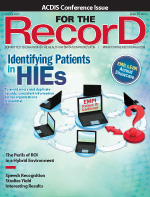 April 23, 2012
April 23, 2012
Coding for Hypertension
For The Record
Vol. 24 No. 8 P. 28
Blood pressure is a measurement of the resistance against the artery walls as the heart pumps blood. Narrow, stiff, or clogged blood vessels may increase blood pressure. The constant elevated resistance may lead to chronic or acute health conditions such as heart disease or stroke.
Blood pressure can vary during the day. Therefore, one elevated blood pressure reading cannot be diagnosed as hypertension. ICD-9-CM code 796.2 is assigned for elevated blood pressure without a diagnosis of hypertension and for transient or borderline hypertension. Once hypertension is established by a physician, a code from category 401 is assigned, with a fourth digit required: 0 for malignant, 1 for benign, and 9 for unspecified. Do not assign a code for benign or malignant hypertension unless it is specifically documented by a physician.
There are two main types of hypertension: primary (or essential) and secondary. Primary hypertension has no known cause and gradually develops over many years. Primary hypertension is classified to category 401.
Hypertension caused by an underlying condition is termed secondary hypertension. This type tends to appear suddenly and causes higher blood pressure than does primary hypertension. Common causes include polycystic kidney disease; adrenal gland tumors/disorders (eg, Cushing’s syndrome); congenital defects of blood vessels; certain medications such as birth control pills, decongestants, and pain relievers; renal artery stenosis; and hyperparathyroidism
Two codes are required to classify secondary hypertension: one for the underlying etiology and one from category 405 to identify the hypertension. The sequencing of these two codes will depend on the circumstances of admission. Similar to category 401, category 405 requires a fourth digit to identify if the hypertension was malignant (0), benign (1), or unspecified (9). A fifth-digit subclassification is also needed to specify if the secondary hypertension was renovascular (due to renal artery).
A hypertensive emergency is when extremely elevated blood pressure results in organ damage. Malignant and accelerated hypertension (401.0) are both types of hypertensive emergencies, with similar treatments and outcomes. However, to diagnose malignant hypertension, papilledema or retinal hemorrhage must be present. Caution should be used in querying for accelerated or malignant hypertension as a principal or a secondary diagnosis because these are relatively rare and symptomatology must be present.
Hypertensive urgency must be distinguished from hypertensive emergency. Hypertensive urgency is defined as severely elevated blood pressure (systolic greater than 220 mm Hg or diastolic greater than 120 mm Hg) with no evidence of target organ damage. Because there is not a specific code assignment for hypertensive emergency or urgency, the physician may need to be queried for clarification as to the specific type of hypertension for appropriate code assignment.
Hypertension with certain heart conditions are assigned to a code from category 402, Hypertensive heart disease, when a causal relationship is stated or implied. Use only the code from category 402 to identify both the hypertension and the heart condition, with the exception of heart failure. If heart failure is present with the hypertensive heart disease, also assign a code to identify the specific type of heart failure (category 428). The same heart conditions mentioned above with hypertension, but without a stated causal relationship, are coded separately. Sequence according to the circumstances of the admission.
Assign codes from category 403, Hypertensive chronic kidney disease, when conditions classified to category 585, Chronic kidney disease, and 587, Renal sclerosis, unspecified, are present with hypertension. Unlike hypertension with heart disease, ICD-9-CM presumes a cause-and-effect relationship and classifies chronic kidney disease with hypertension as hypertensive chronic kidney disease.
Assign codes from combination category 404, Hypertensive heart and chronic kidney disease, when both hypertensive chronic kidney disease and hypertensive heart conditions are stated in the diagnosis. Assume a relationship between the hypertension and the chronic kidney disease whether or not the condition is so designated.
Coding and sequencing for hypertension are dependent on the physician documentation in the medical record and application of the Official Coding Guidelines for inpatient care. Also, use specific AHA Coding Clinic for ICD-9-CM and American Medical Association CPT Assistant references to ensure complete and accurate coding.
— This information was prepared by Audrey Howard, RHIA, of 3M Consulting Services. 3M Consulting Services is a business of 3M Health Information Systems, a supplier of coding and classification systems to more than 5,000 healthcare providers. The company and its representatives do not assume any responsibility for reimbursement decisions or claims denials made by providers or payers as the result of the misuse of this coding information. More information about 3M Health Information Systems is available at www.3mhis.com or by calling 800-367-2447.
ICD-10-CM Coding for Hypertension
In ICD-10-CM, hypertension is no longer classified as malignant, benign, or unspecified. The following are the categories available for hypertension in ICD-10-CM:
• I10, Essential (primary) hypertension;
• I11, Hypertensive heart disease;
• I12, Hypertensive chronic kidney disease;
• I13, Hypertensive heart and chronic kidney disease; and
• I15, Secondary hypertension.
Code I10 is used when hypertension is not further specified or associated with another disease process such as chronic kidney disease. Hypertension described as benign, malignant, controlled, uncontrolled, and primary would be coded here unless it belongs in another category code. A condition of elevated blood pressure without a diagnosis of hypertension is classified to code R03.0, Elevated blood pressure reading without diagnosis of hypertension. Postprocedural hypertension, I97.3, is located in the category for Intraoperative and postprocedural complications and disorders of the circulatory system, not elsewhere classfied.
— AH



